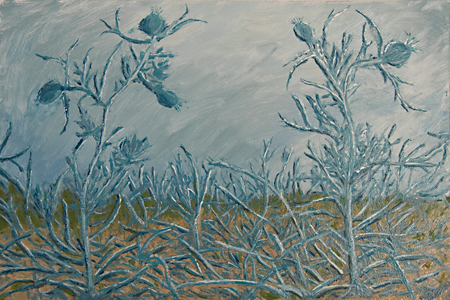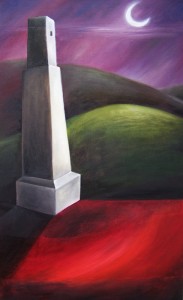Pitcher thistle in oil and as photo.
Archives for painting
In Retrospect
I’m back from the road trip, muddling about until my body decides it’s home.
Muddling about includes mulling over ideas, thoughts, notions, and niggles that life has handed me. Here’s a set of thoughts that I’ve maundered through in the last few days.
People, making conversation with the plein air worker, often ask “How long have you been painting?” My stock answer is “Oh, about 5 years.”
But I was cleaning up some old piles of stuff today, and ran across a whole covey of watercolors and acrylics that were dated 1999. Now my math is bad, but not that bad. Somehow time, or memory, had gotten short-circuited. I remember the class now; it was “painting the figure in watercolor,” and I stumbled into it by mistake, much, I suspect, to the horror of the very nice instructor.

Rosie, Winter, 1999, watercolor, 15 x 22″
Not the kitchen sink
An ideal blog post should be a nutritious snack like a granola bar: a little filling but not too heavy, containing a few sweet nuggets, and hopefully good for you. Well, you know how there’s usually a little spilled flour, a sticky spot of honey, and a few escaped raisins lying around after a cooking stint? And possibly a few items from earlier efforts? Welcome to my clean-up post.

One stray ingredient is one I deliberately left out of last week’s post on some modern Chinese abstract artists, for reasons of space and time. But Che Chuang’s painting of a head, shown above, struck a real chord with me. It reminded me strongly of two heads of my own that have appeared in these pages. The level of abstraction, original color, and even shape are not so very different.
Fifth Moon abstraction
 My ongoing look into Japanese and Chinese painting has turned up a few new/old ideas, and blown me away with some new discoveries. It’s becoming quite clear why I felt attracted to it; these are themes I’ve written on before in the context of my own photography (e.g. here and here).
My ongoing look into Japanese and Chinese painting has turned up a few new/old ideas, and blown me away with some new discoveries. It’s becoming quite clear why I felt attracted to it; these are themes I’ve written on before in the context of my own photography (e.g. here and here).
The first idea is about the level of abstraction frequently present. Many of those mountains and rivers seem as much about shapes and textures as about landscape, more evocative than representational. Sometimes there’s an interesting mix of broad abstraction and realistic detail, as in the thousand-year-old Travelers amid Mountains and Streams by Fan Kuan, shown at left.
A second realization is that, like similar works at different times, this one by Fan Kuan smacks of the sublime. This is evident in the language used to describe it by historian Patricia Ebrey (Cambridge Illustrated History of China, or Wikipedia):
Jutting boulders, tough scrub trees, a mule train on the road, and a temple in the forest on the cliff are all vividly depicted. There is a suitable break between the foreground and the towering central peak behind, which is treated as if it were a backdrop, suspended and fitted into a slot behind the foreground. There are human figures in this scene, but it is easy to imagine them overpowered by the magnitude and mystery of their surroundings.
Painting Expedition and Road Trip
I’m on the road with Jer, working on painting scenes from many tiny hamlets in the high desert of eastern Oregon. We started on Monday, it is now Thursday, and I have eight 12 x 16″ plein air oil paintings in my boxes in the back of the Honda. I also have a peeling nose (in spite of all precautions against the sun) and a whole set of images, some photos, some memories, of Oregon’s outback.The paintings are too raw to be shown right now, but here are some photos of things I painted:

The Heppner, Oregon, courthouse and uplands

The Condon Library and Lennox Heating and Cooling Store (circa 1903, erstwhile bank and saloon)
Holding the Knowledge
I have just finished an intensive (and intense) 5-day workshop in plein air landscape painting. Later, I may indulge myself and talk about the entire process and the 3 locations we painted at, but for this post I’d like to pose a question which comes out of just one location. The question I’m posing is how does one transfer the knowledge gained in doing one piece of art to her general practice? More specifically, how can I hang onto the insights that my instructor helped me gain and use them when I’m working on my own?
The specifics: On Wednesday we painted at the Willamette River waterfront, in a piece of waste ground, just to one side of the Interstate 405 (Fremont) Bridge as it rises over the river. One humongous stanchion was no more than 10 feet from my painting spot. The roar of the traffic was absolutely constant; it was only maddening if you tried to talk to someone. The field was dusty but large, the sun quite warm, the wind constant, and although there were city amenities beyond us on all sides, a chain link fence and heavily trafficed road cut us off. It was a total enveloping environment, not necessarily unpleasant if you sank into it.
That was Wednesday. On Thursday and Friday, we moved the art school’s painting studio and worked on projects based on one of the plein air pieces. I chose to enlarge upon images and ideas that I gathered from the Under-the-Underpass experiences.
Fremont Bridge 1, photo, June 2008

